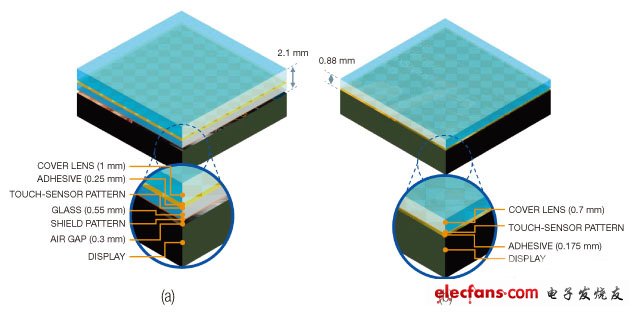Main points
1. Now, in addition to high-end smartphones and tablets, users also expect to use touch screens in other applications, which are gradually appearing in cars and instruments.
2. In the competition between capacitive touch screens and cheaper but unresponsive resistive touch technologies, cost is a limiting factor for applications.
3. Tactile technology tries to simulate the real world feeling environment, its price is falling, and it may make the first progress in the game market.
Since the last touch screen research, the touch screen has established itself in smart phones and is looking for opportunities to enter lower-priced “feature phones†because mobile phone manufacturers expect to grab some share from the high-end mobile phone market. Tablet computers like the iPad and the latest Kindle Fire have also contributed to the popularity of touch screens. As users become more familiar with the interactive and changing touch screens in consumer electronics, they hope to have the same level of interoperability in other non-traditional touch screen areas, such as automobiles, medical electronics, and industrial equipment.
Touch screens have been available for decades, and they usually use resistive touch technology. When using a resistive touch screen, the pressing of the user's finger causes physical deformation of the outer layer of the screen, so that the resistance sensor contacts the bottom surface of the finger. The resistance sensors are arranged in an X by Y array and are separated by a thin and transparent insulator.
Note that the word "press" is used here. Pressing is an action different from touching or swiping. Resistive touch screens have limited responsiveness to multi-touch gestures, such as pinch, zoom, sweep, and scroll. Once users are used to operating their smartphones and tablets with these gestures, they no longer use simple touch screens that lack these features. Touch screens that can respond to complex gestures usually use capacitive detection technology.
Capacitive detection touch technology can generally use self-capacitance and mutual capacitance, but there are some other types, such as projected capacitance. The self-capacitance sensor consists of a series of thin lines of indium tin oxide. It is a transparent conductive material arranged in an XY grid with an insulating layer between the X and Y lines. Touching an area on the grid will change the parasitic capacitance of the sensor to ground. However, this method cannot handle multi-finger touches because the sensor cannot distinguish multiple fingers along the same grid line. Mutual capacitance can detect the change in capacitance at the small intersection of X and Y lines. Because the overlap area is small, the capacitance is also small, but this method is very precise and can measure the position of multiple fingers.
Each scheme has its own advantages and disadvantages. Although self-capacitance sensors usually cannot distinguish the simultaneous actions of multiple fingers, they can generate a strong electromagnetic field for detecting an object, even if the object does not actually touch the screen. Mutual capacitance touch screens can detect and track multiple fingers, but the fingers must touch the screen because the capacitance formed by the two overlapping sensors is very small and their electromagnetic field is extremely weak.
When the user wears gloves, the need for closed contact between the finger and the touch screen may become a problem. Capacitive touch screens have this limitation, which makes people prefer resistive touch screens. Resistance technology also has its advantages in liquid applications or in humid climates, where moisture can affect the performance of electromagnetic fields. Cypress's TrueTouch controller technology attempts to combine self-capacitance and mutual-capacitance technologies to overcome these obstacles.
Both self capacitance and mutual capacitance require the same XY sensor grid. In the case of self-capacitance, the controller must drive X and Y lines simultaneously. In the case of mutual capacitance, the controller transmits X-rays and receives from Y-rays. Because the TrueTouch controller IC uses Cypress's PSoC (Programmable System on a Chip) core, the controller can dynamically configure its I / O pins to instantly convert the transmitter to the receiver. Therefore, whenever the controller scans the sensor grid plate, it can simultaneously detect in two modes (self capacitance and mutual capacitance). The combination of self-capacitance and mutual capacitance enables people to complete multi-touch functions even when wearing thick ski gloves. This capability creates a safety issue with touch screens in cars.
The touch screen in a car is 10 inches or larger, which is usually larger than the screen of a smartphone, which is typically about 4 inches in size. Atmel's MaxTouch series touch screen controllers include mXT768E and mXT540E controllers that have passed automotive certification, and can be used for the center console display, navigation system, and 5-inch to 10-inch touch screen of the rear seat entertainment system. Traditional controllers used for capacitive touch screens require a shielding layer between multiple touch screens to prevent coupling noise from the LCD. Atmel claims that MaxTouch devices provide a signal-to-noise ratio of 80: 1 without the need for a shielding layer, enabling a single-layer sensor design, thereby reducing cost and thickness (Figure 1). High SNR can also detect a finger wearing thin gloves. In general, this technology can detect gloves with a thickness of 1.5 mm, such as leather, wool or cotton gloves.

Figure 1. There is an ITO shield in the touch screen stack (a). Removing such a shielding layer means reducing the thickness and increasing the brightness of the display, but may cause LCD noise problems (b).
Optical Fiber Braided Sleeving
Optical fiber braided sleeving is a protective covering made from braided fibers that is used to protect and organize optical fiber cables. It provides a flexible and durable solution for managing and protecting fiber optic cables from damage and external factors such as dust, moisture, and abrasion.
Optical Fiber Braided Sleeving,Optical Fiber Braided Sleeve,Flame Resist Sleeving,Protect Cable Sleeve
Dongguan Liansi Electronics Co.,Ltd , https://www.liansielectronics.com